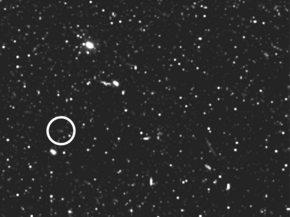 Bebhionn imaged by the Cassini spacecraft in May 2017 Bebhionn imaged by the Cassini spacecraft in May 2017 | |
| Discovery | |
|---|---|
| Discovered by | Scott S. Sheppard David C. Jewitt Jan T. Kleyna Brian G. Marsden |
| Discovery date | 2004 |
| Designations | |
| Designation | Saturn XXXVII |
| Pronunciation | /ˈbeɪvɪn, ˈbɛviɒn/ BAY-vin, BEV-ee-on |
| Named after | Béibhinn |
| Alternative names | S/2004 S 11 |
| Orbital characteristics | |
| Semi-major axis | 17119000 km |
| Eccentricity | 0.469 |
| Orbital period (sidereal) | −834.8 days |
| Inclination | 35.01° |
| Satellite of | Saturn |
| Group | Gallic group |
| Physical characteristics | |
| Mean diameter | 6+50% −30% km |
| Synodic rotation period | 16.33±0.03 h |
| Albedo | 0.06 (assumed) |
| Spectral type | B–V = 0.61 ± 0.10, V–R = 0.51 ± 0.13 |
| Apparent magnitude | 24.1 |
| Absolute magnitude (H) | 15.0 |
Bebhionn (/ˈbeɪvɪn, ˈbɛviɒn/), also known as Saturn XXXVII, is a small, irregular natural satellite of Saturn. Its discovery was announced by Scott S. Sheppard, David C. Jewitt, Jan Kleyna, and Brian G. Marsden on 4 May 2005 from observations taken between 12 December 2004 and 9 March 2005.
Bebhionn is about 6 kilometres in diameter and orbits Saturn at an average distance of 16,898 Mm in 820.130 days at an inclination of 41° to the ecliptic (18° to Saturn's equator) and with an eccentricity of 0.333. The rotation period of Bebhionn was measured at 16.33±0.03 hours by the ISS camera of the Cassini spacecraft. Bebhionn's light curve reflects an elongated shape with large variations in brightness, making it a leading candidate for a contact binary or binary moon.
Name
The moon was named in April 2007 after Béibhinn (Béḃinn), an early Irish goddess of birth, who was renowned for her beauty. In Irish, Béibhinn/Béḃinn is pronounced [ˈbʲeːvʲiːn̠ʲ] (southern accents, English approximation /ˈbeɪviːn/ BAY-veen) or [ˈbʲeːvʲɪn̠ʲ] (northern accents, English approximation /ˈbeɪvɪn/ BAY-vin). The spelling "bh" (older "ḃ") indicates that the second consonant is softened to a "v" sound. The extra "o" in the unusual spelling Bebhionn suggests that the final "nn" should be broad [n̪ˠ], but is not itself pronounced. The name is still pronounced as a compound (and thus sometimes spelled Bé Binn etc.), so the unstressed vowel is not reduced to a schwa.
References
- S.S. Sheppard (2019), Moons of Saturn, Carnegie Science, on line
- ^ Denk, T.; Mottola, S. (2019). Cassini Observations of Saturn's Irregular Moons (PDF). 50th Lunar and Planetary Science Conference. Lunar and Planetary Institute.
- ^ Denk, Tilmann; Mottola, Stefano; Tosi, Frederico; Bottke, William F.; Hamilton, Douglas P. (2018). "The Irregular Satellites of Saturn" (PDF). In Schenk, P.M.; Clark, R.N.; Howett, C.J.A.; Verbiscer, A.J.; Waite, J.H. (eds.). Enceladus and the Icy Moons of Saturn. Space Science Series. Vol. 322. Tucson, AZ: The University of Arizona Press. pp. 409–434. Bibcode:2018eims.book..409D. doi:10.2458/azu_uapress_9780816537075-ch020. ISBN 9780816537075.
- Graykowski, Ariel; Jewitt, David (2018-04-05). "Colors and Shapes of the Irregular Planetary Satellites". The Astronomical Journal. 155 (4): 184. arXiv:1803.01907. doi:10.3847/1538-3881/aab49b. ISSN 1538-3881.
- T. Denk, S. Mottola, et al. (2011): Rotation Periods of Irregular Satellites of Saturn. EPSC/DPS conference 2011, Nantes (France), abstract 1452.
External links
- Institute for Astronomy Saturn Satellite Data
- Jewitt's New Satellites of Saturn page May 3, 2005 (includes discovery images)
- IAUC 8523: New Satellites of Saturn May 4, 2005 (discovery)
- MPEC 2005-J13: Twelve New Satellites of Saturn May 3, 2005 (discovery and ephemeris)
- IAUC 8826: Satellites of Jupiter and Saturn April 5, 2007 (naming the moon)
| Moons of Saturn | |||||||
|---|---|---|---|---|---|---|---|
| Listed in approximate increasing distance from Saturn | |||||||
| Ring moonlets | |||||||
| Ring shepherds | |||||||
| Other inner moons | |||||||
| Alkyonides | |||||||
| Large moons (with trojans) | |||||||
| Inuit group (13) |
| ||||||
| Gallic group (7) | |||||||
| Norse group (100) |
| ||||||
| Outlier prograde irregular moons |
| ||||||
| Saturn | |
|---|---|
| Geography | |
| Moons | |
| Astronomy | |
| Exploration | |
| Related | |